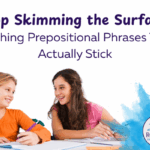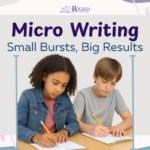 Children are naturally fascinated by learning through nonfiction books, but many don’t know how to navigate the complexity of the text. Small groups and guided reading groups are the perfect places to teach and reinforce how to read nonfiction texts.
Children are naturally fascinated by learning through nonfiction books, but many don’t know how to navigate the complexity of the text. Small groups and guided reading groups are the perfect places to teach and reinforce how to read nonfiction texts.
First, you’ll want to choose strong nonfiction texts! Think about what the students want to learn about. Nonfiction books have come such a long way since I was a child. I have found that animals and sports are typical winners, but other kids might have more specific interests, such as; natural disasters, countries, inventions, etc. There are many suggestions and teaching ideas in this post at Literary Fusions.
I recently taught nonfiction texts to a group of 3-5 graders in Guided Reading. (If you’re interested in instructional coaching for your campus, contact us.) Here is a snapshot of what went down:
- Not knowing the kids, yet, I went with a standby for students this age group. I chose one book on penguins and another on gorillas. These particular books were split into very specific sections, so I searched through each to find very two strong sections to use. I knew I wanted to focus on supporting details where I would provide the central idea for the section and students would find the supporting details in that section. So it was important to find strong sections for this purpose and sections that the students would be interested in reading.

- My main purpose was to get the students to find supporting evidence, but I also wanted to take time to help these students understand text features and how to use them. I had each group start at the table of contents. We talked about how this page explains what all the sections in the book are about. I provided them a clue, like “I want to read about what penguins eat. Which section should I read?” This forced the students to read through the table of contents and decide where this information would be located. This is authentic reading! People don’t generally read nonfiction cover to cover, instead, they search for the information they need and want. Finally, one of the students identified the “Hunters and Hunted” section. Of course, I complimented him and had him explain his thinking to the rest of the group. We flipped to that page. Both groups were high transitional or fluent readers, so it was important to focus on vocabulary strategies. I had them find the bolded words on the page and we talked about how we could figure out what they mean. I taught them to read the sentence and see if they could make sense of the word and if not, we read the sentences before and after to see if that helps. This time was invaluable. We worked together to use context clues to solve the meaning of words in a real text. I took notes on the strategies the students were using. The last text feature we worked on was looking at the pictures and reading the captions. This helped the students begin to realize what the text was about.
- Now it was time to begin reading. I told them the central idea of each section they were going to read and provided the purpose for reading. “I want you to read and find evidence that supports the central idea __.” I had the fluent readers write their answers in their journal. The transitional group shared their thinking orally. I spent time listening to them read and to their thinking. I helped to clarify and direct their attention. I always asked them to prove how it supports the central idea.
- In future meetings, I would want the students to come up with the central idea themselves.
How do you teach nonfiction in small groups?


